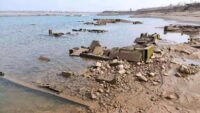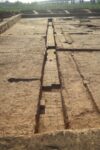 A stone vessel found in the remains of a large mausoleum in Luoyang, central China’s Henan Province, has confirmed the tomb belonged to Eastern Han Dynasty emperor Liu Zhi (r. 146 – 168 A.D.). Archaeologists have thought the tomb complex was Liu Zhi’s based on reports in ancient chronicles, but until now there was no archaeological evidence for the contention.
A stone vessel found in the remains of a large mausoleum in Luoyang, central China’s Henan Province, has confirmed the tomb belonged to Eastern Han Dynasty emperor Liu Zhi (r. 146 – 168 A.D.). Archaeologists have thought the tomb complex was Liu Zhi’s based on reports in ancient chronicles, but until now there was no archaeological evidence for the contention.
According to the latest excavation, the 25-cm-tall basin-shaped vessel with a diameter of 80 cm was found inscribed with a manufacturing year — the third year of Guanghe, or AD 180.
Wang Xianqiu, an associate researcher of the Luoyang City Cultural Relics and Archaeology Research Institute, said Guanghe was a reign title of Liu Zhi’s successor Liu Hong, and the stone vessel was produced when Liu Hong was building the mausoleum for Liu Zhi.
“Together with the previous documents about the location of the emperor’s tomb, the discovery makes us almost certain that it is the tomb of emperor Liu Zhi,” said Wang, who led the excavation project of the mausoleum.
Luoyang was the capital of the Eastern Han Dynasty (25 – 220 A.D.) and its location on the banks of the Luo River, a tributary of the Yellow River, held religious significance as well as economic value. Since excavations at the  Eastern Han cemetery site in Luoyang’s Baicaopo Village began in 2017, more than 100 tombs dating back as far as 2,200 years ago have been discovered at the site on the south bank of the Luo. Originally on a platform above the river, the tombs were submerged when the river flooded this summer, washing away the platform and taking half the riverbank with it. They resurfaced after the water level dropped, but their condition is precarious and it’s not clear how best for archaeologists intervene.
Eastern Han cemetery site in Luoyang’s Baicaopo Village began in 2017, more than 100 tombs dating back as far as 2,200 years ago have been discovered at the site on the south bank of the Luo. Originally on a platform above the river, the tombs were submerged when the river flooded this summer, washing away the platform and taking half the riverbank with it. They resurfaced after the water level dropped, but their condition is precarious and it’s not clear how best for archaeologists intervene.
The imperial mausoleum is a huge building complex in the northeast corner of the Baicaopo cemetery. It can be divided into three sections, each  with their own walls and gates independent of each other. The buildings are arranged on a grid of courtyards and include the remains of houses, patios, wells, roads, drainage channels and other facilities found in inhabited towns. Ancient literature suggests these sites were inhabited by the living — cemetery administrators, guards, service personnel, low-ranking concubines, or perhaps nobles appointed to keep vigil over the tomb of the deceased emperor. The emperor himself was buried under ground in a palace for the dead.
with their own walls and gates independent of each other. The buildings are arranged on a grid of courtyards and include the remains of houses, patios, wells, roads, drainage channels and other facilities found in inhabited towns. Ancient literature suggests these sites were inhabited by the living — cemetery administrators, guards, service personnel, low-ranking concubines, or perhaps nobles appointed to keep vigil over the tomb of the deceased emperor. The emperor himself was buried under ground in a palace for the dead.